Polyethism in an Oriental Hornet (Vespa orientalis) Colony
Abstract
The present study describes the daily activities of the Oriental hornet (Vespa orientalis) workers older than 48 hours as observed in an Artificial Breeding Box (ABB) in our laboratory at the peak of the active season. These workers were picked randomly from a population of a single nest that was enabled to free egress into the field. The study points to the existence of polyethism in the nest of V. orientalis with the adult worker hornets, separating them into three groups in accordance with the frequency and nature of their exits from the nest, and the tasks which they perform. This polyethism was not age-dependent. Recordings were made of the following vespine activities: the frequency of exits to the field during various hours of the day and the various roles undertaken by the hornets. Also investigated was the assignment of tasks among the hornets and the preference given to some tasks over others. The general organization of traffic and other movements in the colony is discussed.
1. Introduction
The Oriental hornet (Vespa orientalis) is prevalent throughout the countries of the Mediterranean basin and also in the Near East as far as India [1]. After a period of hibernation, the queen seeks out a site suitable for founding a colony. In the Tel-Aviv district, the Oriental hornet queen prefers a site comprised of khamra (red loam) or kurkar (calcareous sandstone) soil. The primary nest is built by the queen alone and is known as an “embryonic nest.”
While attending the initial larval brood, the queen continues to build additional comb cells until the brood comb contains 20–30 cells. After about a month, the initial workers that eclose relieve the queen of various duties like the provision of food for the developing brood, cleaning of the nest, and further building and expansion of the nest, leaving to the queen its main role of ovipositing into the comb cells, one egg per cell comb [2]. While the queen′s ovipositing activities all take place within the nest, without any need for her to leave the nest, the workers in the course of the active season engage in various activities that are strongly interconnected and focus mainly on tending the brood. Additional duties of the workers entail further building or enlargement of the nest accomplished by the accretion of plant organic matter or inorganic matter like khamra soil; these are masticated by the building hornet and then deposited as horizontal stripes of building material which ultimately give rise to the hexagonal comb cells that make up the combs in the nest. When the nest is (inadvertently) exposed to light, an envelope is built around it as a protective measure.
With the increase in the nest population, digging activities are undertaken to enlarge the volume of the nest cavity. This is typical for V. orientalis as well as other social wasp species like Paravespula germanica. If the dug particle is large, the building worker lifts it with its mandibles and throws it outside the nest. However, if the dug particles are small, that is, if the terrain is mostly sandy, the digging hornet collects and fastens the individual particles into a particle of appropriate size, lifts it in the air, and disposes of it some 5–10 meters from the entrance.
At the nest entrance, we find hornets whose primary duty is to stand guard and prevent foreigners, like hornets from other nests, or various harmful organisms from endangering the nest. To this end, the sentinel hornet probes with its antennae any hornet trying to enter the nest. These sentinel hornets are replaced by others every few minutes and they probably succeed in repelling parasites. Continuing with our listing of hornet daily activities, we note that in warm days, there are hornets at the nest entrance that assume a rather tall stance and perform ventilatory activity to regulate the nest temperature [3]. The worker hornets engage in flight activity for the purpose of (1) introduction of building materials, to which end the hornets fly from place to place, taste the materials in the field, and decide whether they are suitable as building materials, (2) foraging flights in the course of which the hornets collect food materials, (3) flights outside the nest which are intended to get rid of waste materials, including soil dug up for enlarging the nest, uneatable parts of insects, dead larvae, and so forth. All the aforedescribed activities take place during the main active season which lasts several months [4–8].
At the end of the active season, from September until December, there is a drop in the intensity of activities in the nest and also a drop in the overall size of the worker population. Instead, during this period, there is eclosion of the sexual forms, first the drones and then the queens. Once the eclosed queens accumulate in their body a sufficient supply of storage materials, they commence their wedding flight, and after copulation, the fertilized queens return to the nest, remaining there till the onset of rains, whereupon they depart, seeking a dark and dry spot to hibernate there until the spring.
The purpose of the present study was to try to ascertain whether adult hornet workers persist throughout in one single task or rather there is a shift in tasks in accordance with age or nest requirements.
2. Materials and Methods
The study was carried out in two stages. Stage one: observations were made on hornets of varying ages between July and the end of August, 2006. Stage two was undertaken in 2007, during August and September, and involved 4 different groups of the same age, namely, hornets that had just eclosed.
The experiments pertaining to this study were undertaken on the Oriental hornet V. orientalis (Hymenoptera, Vespinae). A nest was located at the end of May-June in the Tel-Aviv University Botanical garden and after initial observations at the beginning of June, the nest was transported in an enclosure to the Vesparium, namely, an Artificial Breeding Box (ABB), whose dimensions were 40 × 35 × 20 cm. The original nest bore 50 workers at different ages, apart from a viable queen and a comb with 85 cells containing brood at varying ages, including about 25 pupae. The nest was anesthetized and treated as previously described [9]. All its population was kept sealed for a week in the ABB. Soil comprised two-thirds of the ABB′s volume (intended to stimulate the hornets to dig as in a natural nest), and above this soil we laid the comb collected from the field and its adult population in a vertical position. As long as the ABB was kept sealed, the workers continued to amend the comb and ensure that the cell walls remained as in nature, that is, with an orientation toward the gravitational force (Figure 1).
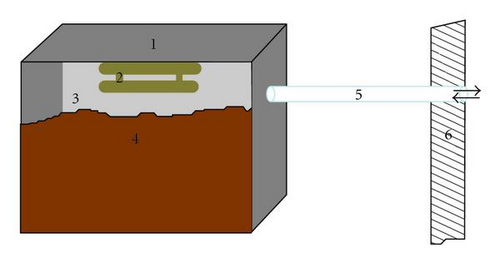
During Stage 1, and right after the nest anesthetization in the field, we marked 35 adult workers aged 48 hours or more with labels bearing 5 colors and a wide range of numbers (Figure 2). The labels (Opalith plattchen, Germany) bore the colors white, yellow, red, green, and blue, while the numbers ranged from 1 to 99, as customary in labeling the queens of bees. The tagging was effected with special glue on the back of the thorax. One week later, the outlet from the ABB and the Vesparium was opened, enabling free egress from the ABB and the vesparium to the field and back. Our tagging technique enabled us to identify the departing and returning hornets both by color and number, as well as by recording the departure and entry times. Our results pertaining to stage 1 are based on observations of 23 out of 35 hornets that survived and were active throughout this stage. In all, we recorded 2517 egresses of hornets from the ABB.

During Stage 2 in the nest kept inside the ABB in the Vesparium, which contained workers at various ages, we introduced gradually 4 groups of young hornets (about one day posteclosion) which were gathered from another nest kept in the laboratory. Each of the four groups (comprised of 8–16 individuals) was assigned and marked by different colors and numbers. The observation periods of the four groups were as follows: first group—from July 31 to September 2, second group—from August 5 to September 20, third group—from August 22 to September 20, and fourth group—from September 9 to September 25. All four groups were viewed in the course of 10 to 16 working days, with close to 7000 egresses from the nest recorded during this stage. The length of observation per group was dependent on and determined by the survival rate in the group, that is, the longer the survival, the longer the observation period, and vice versa.
Additionally, we observed also other activities undertaken by the adult hornets, like feeding of the larvae and various digging and hunting functions, recording the distribution of all these activities among different members of the nest.
Statistical analysis of the findings was carried out by applying one-way ANOVA and paired and independent sample t-test. P value of P < .001 was determined as the significant level.
3. Results
In the first few days after eclosion, the hornet workers were photophobic and did not exit the nest. Most of them engaged in intranest duties, such as connecting the comb cell walls, mending the margins of the comb, cleaning activities, and also in attempts to accustom themselves to the nest environment. The hornets start exiting the nest on the third day after eclosion but the majority exits the nest only on the fourth day after eclosion.
The hornets that exit the nest bring back food, water, and building materials, clear the nest from garbage and enlarge it by digging activity, throwing out the dug soil and stone particles. Such assignment of duties in dependence with age is indicative of polyethism between young and old hornets.
3.1. Stage 1
During Stage 1 entailed, a follow-up on 23 tagged hornets that age-wise comprised a heterogeneous group. Our observations showed that already at the onset of extranest activities, there was disparity in the frequency of exits, with some hornets exiting at very high frequency for brief (up to one minute) flights. Such brief flights, usually associated with exits of digging hornets, occupied 51% of the total exit flights throughout the observation period. As for digger hornets, their digging activity may repeat 50–60 times without stop, but thereafter they rest for 10–15 minutes before resuming the same digging activity. During the second week of observation, we noted two digger hornets (3w and 4y) that were very active and performed more than 60% of the total exits in the tagged group. Of the two, hornet 3w was seen to exit to the field every 1.9 ± 0.4 minutes (n = 259), whereas hornet 4y exited every 2.7 ± 0.6 minutes (n = 160). During the same period, the remaining hornets in the group exited the nest once every 21.7 ± 14.1 minutes (n = 262). In fact, throughout the observation period, there were 3 hornets in the first subgroup that were persistent and very active in their digging activity, namely, 3w, 4y, and 7y (Figure 3). Their mean numbers of exits per hour during the observation period were, respectively, 13.7 ± 7.2 (n = 452), 10.2 ± 5.04 (n = 411), and 10.5 ± 4.8 (n = 438). We need to point out again that this subgroup of hornets engaged primarily in digging activity, namely, the removal of grains of sand from the ABB, and that they persisted in this activity for 5 whole weeks—from the end of July to the end of August. All the remaining hornets exited the nest at a much lower frequency, and engaged in a wide range of activities, including the introduction of building materials or food into the nest, but mostly interior nest duties, like tending to the developing brood.
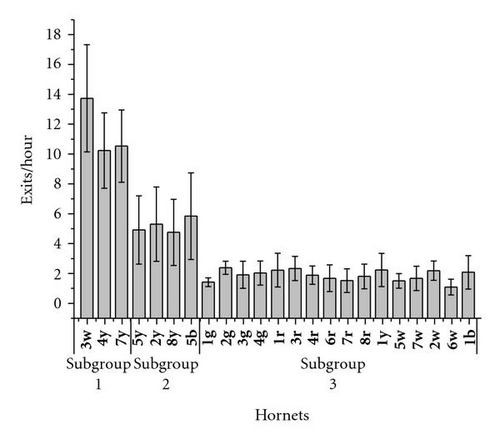
The second subgroup of hornets (5y, 2y, 8y, and 5b) incorporated digging activity on certain days with other duties that did not require high frequency of exits from the nest like the introduction of food or building materials into the nest, but rather included the feeding of the larvae, construction and mending of the nest, and maintaining a steady nest temperature. The frequency of exits per hour by these hornets ranged between 4.7 ± 4.4 and 5.9 ± 5.8 (n = 446).
The third subgroup, the largest of the three (16 hornets), specialized in various intranest duties but typically did not participate in digging activities entailing brief exits from the nest. In this subgroup, the number of exits per hour ranged between 1.08 ± 1.05 and 2.3 ± 1.5 (n = 770). Thus, the differences in exits from the nest by the three subgroups proved statistically significant (F = 239.04; P = 1.08−14).
Our observations on the group that was heterogeneous insofar as age showed that apart from the juvenile age polyethism (i.e., hornets up to 2-3 days of age display activity only within the nest), there is also age-independent polyethism characterized by the frequency of exits from the nest and the primary duties performed.
The two main roles undertaken by the hornets under observation were digging activities and the introduction of captured bees into the nest. Occasionally, however, the digging hornets cease digging and turn to another duty. Regarding the loading and unloading of soil, the entire process lasts only about a minute, and here there were three such hornets in the observed group.
As for the introduction of captured bees into the nest, our observations showed that during two weeks (in the end of August), the nest contained 18 labeled hornets, half of which commenced bringing entire bees from the field. Follow-up of these bee-collecting hornets for about 30 hours showed that three of them actually brought in about 70% of the collected bees, or 23 out of 33. Again, it was the same already-mentioned three hornets that were brought in the greatest catch of bees.
The hornet that brought an entire bee into the nest enabled the other hornets remaining behind in the nest to break up the apine prey into small bits, which were ultimately fed to the developing larvae. As already mentioned, there were three hornets that were constantly engaged in capturing bees in the field, but apart from bees, also other captured insects were introduced into the nest, such as the green larval stages of butterflies or grasshoppers. The latter “catches,” however, were much less frequent than the apine ones and interestingly, the other insects were not brought in by the hornets that brought in the bees.
3.2. Stage 2
In Stage 2 of the study, undertaken in August-September of 2007 (the peak of the hornet activity), the observations were repeated, but now the follow-up was carried out on four groups of homogeneous age, which eclosed in another nest and were incorporated consecutively into the experimental colony. These hornets were labeled a day post eclosion and were constantly observed till termination of the experiment.
With Group 1, follow-up was carried out on 13 worker hornets during 14 working days (between July 31 and September 2). Mean exits per hour of these hornets were 6.7 ± 4.0 (n = 1798). Yet the exit frequency of two digger hornets (15r and 8r) markedly exceeded this mean, attaining up to 30–40 exits per hour with an overall mean of 16.09 ± 7.3 and 13.5 ± 7.7, respectively (Figure 4(a)). There were also two extremely “passive” hornets (16r and 14r) who never exited more than 5 times an hour with mean exits of 2.3 ± 2.2 and 2.49 ± 2.06, respectively. The majority (9 of 13) hornets in Group 1 displayed a variable rhythm of activities in that following marked flight activity, there were periods when most of the time they remained inside the nest. The variance in the frequency of exits of the three subgroups was statistically significant (F = 52.04; P = 5.17−6).

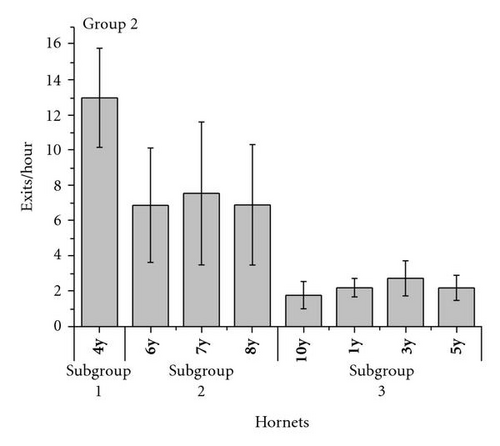
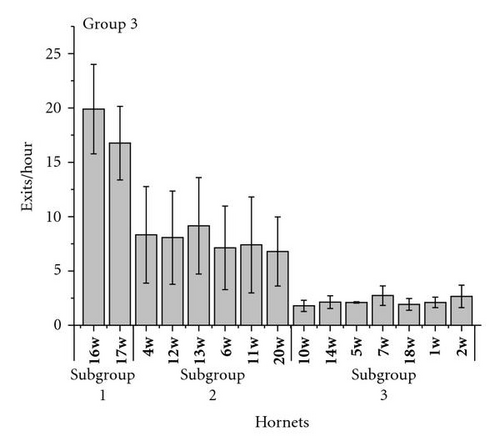
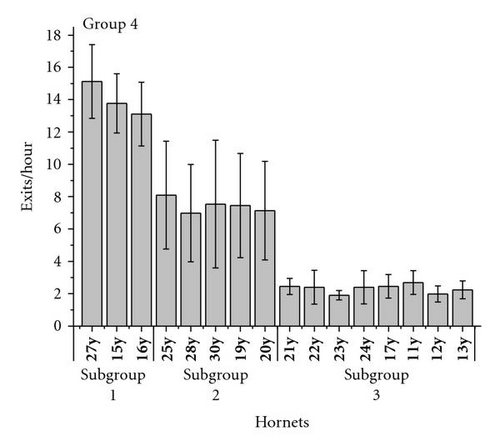
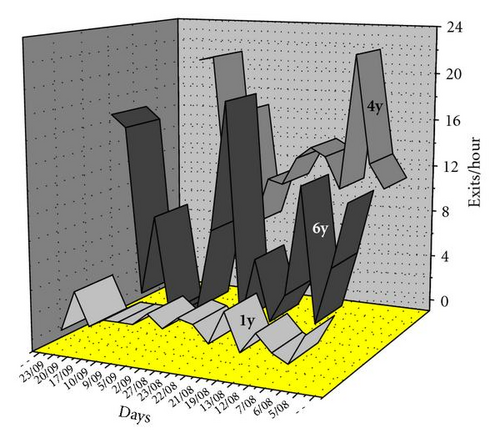
With Group 2, 15 days of follow-up were carried out on 8 hornets between August 5 and September 20. Mean of exits recorded per hour was 5.4 ± 3.9 (n = 1088). A high degree digging activity was observed in one hornet—4y (Figure 4(b)). Another four workers exited at a much lower frequency (1y, 3y, 5y, and 10y), while the remaining three (6y, 7y, and 8y) were intermediary in terms of exit rate.
Group 3 involved 15 hornets that were labeled on August 19 and were observed during 10 days between August 22 and September 20. We recorded in this group 1569 exits with mean hornet departures from the nest being 6.6 ± 5.5 times per hour. Already from the initial days of observation, there was a clear dichotomy into three subgroups with respect to flight activities and other functions performed. Thus, the first subgroup was composed of two digger hornets (16w and 17w) whose rate of exits was 19.9 ± 8.2 and 16.7 ± 6.8 per hour, respectively (Figure 4(c)). These two digger hornets dug more or less intensively throughout the observation period. The second subgroup was comprised of 7 workers (1w, 2w, 5w, 7w, 10w, 14w, and 18w) whose main tasks were the aforedescribed, various, intranest activities. The exit frequency in this subgroup was accordingly rather low (about 2-3 exits per hour). The third subgroup was comprised 6 hornets that displayed behavioral flexibility in that they combined interior duties with searches for food and building materials, and even participated in the digging activities. The mean values of their flight frequencies are intermediary between the other two subgroups with the differences between the three subgroups statistically different (F = 264.96; P = 1.17−10).
Group 4 (composed of 16 workers) was followed up during 16 working days between September 9 and September 25. In the course of observations, the hornets of this group exited a mean 6.1 ± 4.6 times per hour (n = 2474). Again, as in the previous groups, we divided the group into three subgroups whose differences in respect to flight frequency proved statistically significant (F = 610.16; P = 1.4−13). The first subgroup entailed three digger workers (15y, 16y, and 27y) that exited the nest 13–15 times per hour (Figure 4(d)). The second subgroup was comprised of 5 hornets (19y, 20y, 25y, 28y, and 30y) whose exits from the nest amounted to about half those of the first subgroup. The remaining 8 hornets comprised the third subgroup and these hornets performed on the average, not more than three flights per hour.
We need mention here also another role played by hornets of subgroups 2 and 3 of the four major groups, namely, the hunting activity, mainly the predation on bees. In this regard, our observations showed that of the 13 hornets of group 1, only four were seen introducing captured bees into the nest, and of these, the most successful was 23r, that brought in about two-thirds of the catch. Of the 15 hornets of group 3, only 4 engaged in bee hunting. Of the 16 hornets of group 4, only two (17y and 24y) were seen introducing bees into the nest. From all of the above, we gather that bee hunting is a role in itself in the nest of V. orientalis, taken up by only a few hornets and not in equal measures.
4. Discussion
The appearance of polyethism in its various forms is typical for all genera of social insects but particularly for Hymenoptera and Isoptera, including the social wasps. Actually, there are various types of the phenomena, such as age- (temporal), caste-, sexual-, and size-dependent polyethism [4, 5, 10–12].
The Oriental hornet (V. orientalis) is a digging hornet and a significant part of its activity entails brief flights out of the nest (digging exits) which are carried out practically throughout the active season. Our observations on natural nests in the field have revealed that from August to the beginning of September, the traffic at the nest entrance in large colonies can amount to more than 500 exits per 5 minutes [13], and most of these exit flights are associated with activities to enlarge the nest. Our findings during Stages 1 and 2 of our study show that only a minority of the adult workers engage constantly in digging activity, whereas the other hornets leave the nest more infrequently and for longer periods of time, bringing back food and building materials, and mostly performing various tasks inside the nest. Accordingly, the adult hornet population can be divided into three groups by the frequency of their exits from the nest (i.e., the roles which they perform). Moreover, the differences between the three groups are statistically significant, and the observed polyethism is not age-dependent. Age polyethism appearing in V. orientalis is during the first two days after eclosion, when the workers remain in the nest and perform various intranest functions like thermoregulation and feeding of the brood, and only on the third day, they do some of the new hornets commence exiting the nest and participating in activities like digging, cleaning the nest, and bringing back food and building materials. This phase of the phenomenon could appropriately be called juvenile age polyethism.
It would seem that activities of the hornets also dependent on the size of the population. Thus, at the peak of the active season, when the population is largest and cell-building is maximal, about 40% of the workers engage in intensive digging activities. However, when unlabeled hornets were randomly removed from the nest, the labeled hornets that were engaged in digging ceased this activity for several days and switched to other duties, like feeding the brood and bringing in food, until the number of workers increased sufficiently to enable the workers to return to their previous role. Apparently, the enlargement of the nest by digging is under certain conditions a secondary activity, whereas tending to the brood and to the nest proper is preferable activities. A similar occurrence of polyethism and work assignment dependent on size of the population has been reported in various other species of wasps [14–19]. As for the appearance of age polyethism entailing initial work within the nest and subsequent activity also outside the nest, this has been widely observed in other species of social insects. Elsewhere, various species of termites are characterized by age, caste, and sexual polyethism [20–23], while ants display age and caste polyethism [24–27]. It is also known that honey bees (Apis mellifera) show a tendency to perform different types of activity at different ages [28–32]. Investigation of age-dependent division of labor in five species of Vespa (simillima, analis, crabro, mandarinia, and tropica) [33] has shown no relationship between age and labor.
To recap, we have shown in the present study that at the peak of the active season in all four of our experimental groups, there was already during the initial days of flight activity a clear division of the hornets into three subgroups depending on the rate of flight exits. This division was statistically significant and not dependent on age.
Thus, in the first subgroup, entailing 52 labeled hornets in all four groups, 8 hornets (about 15%) engaged in digging activities, with several scores of exits per hour for brief flights of up to one minute. This percentage of digging hornets was fairly constant in all four groups, and these hornets displayed digging activity only, with brief rest periods, during two thirds of the observation time, while in the remaining time, they engaged in digging coupled with prolonged flight periods of 5–30 minutes.
In the second subgroup, 23 of 52 hornets (about 45%) engaged in enlarging the nest by digging (as in the first subgroup), and this is during 15–20% of the observation time, whereas in the remaining time (on other days), they displayed a variegated spectrum of activities combining the bringing of food and building materials with intranest activities like thermoregulation, guard duty, and nursing of the comb brood. Here, the digging-related flight exits comprised no more than a quarter of the total types of exit flights.
In the third subgroup, comprising 21 of 52 hornets or about 40% of the labeled population, the hornets also engaged in the various aforementioned activities but with the principal difference that in this subgroup, none of the hornets engaged in digging activities.
When reviewing all three subgroups, we note that the second one displays the greatest behavioral flexibility despite a certain correspondence between it and the first and third subgroups insofar as the range of roles performed. Figure 5 depicts the daily activity of individual hornets representing the three subgroups. Thus, 4y (of subgroup 1) is a digging hornet with a high rate of exits from the nest, 6y (of subgroup 2) is a hornet displaying variable behavior in that a spell of days with high exit rates from the nest is replaced by a run of days with exit rates, and 1y (of subgroup 3) is a hornet that scarcely left the nest and did not engage in digging.
The present findings confirm that the proportional percentage of each of the subgroups within the described hornet colony can change in the course of the active season, being dependent both on the stage of development of the colony as well as on the requirements or needs of the nest. For instance, there is indeed correlation between size of the hornet population and the number of hornets that engage in digging activity. We have observed that on certain days in the peak of the season, when there was an excess of workers, the proportion of labeled hornets that actively engaged in digging attained up to 40%. Concurrently, our attempt to reduce colony size to a third of its size resulted in a marked reduction in digging activities. At the end of the season (October), when there is no further need for enlarging the nest, the percentage of digging hornets becomes accordingly low.
Our observations clearly show an assignment of specific roles to various members of the hornet colony and this, despite an absence of any specific morphological characteristics in association with any specific role. Insofar as their work is within the nest, we failed to notice any of the hornets performing a particular duty at a particular time, but rather their tasks were changeable with time. Also, we did not find any evidence that role assignment in the adult hornet population (i.e., more then 3 days after eclosion) was age-dependent.
Acknowledgments
We wish to thank the Israeli Ministry of Immigrant Absorption for their generous support of the first author. The experiments comply with the current laws of the state of Israel.




